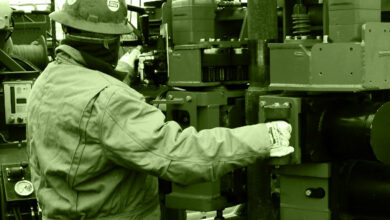New lifeboat design replaces hook system with drop-in-ball technology to improve safety
By Yvette Roper, Maersk Drilling
It’s logical – a lifeboat is supposed to save lives, not cause deaths or injuries. Then why were people in the maritime and offshore industry continually getting hurt in pure safety exercises? This question bothered Bent Nielsen, senior general manager of Maersk Drilling. So he did a study, wrote a wish list and created a safe lifeboat concept for his fellow seamen.
A prototype of the boat was presented publicly for the first time at a meeting of the International Maritime Organisation (IMO) in London on 28 May 2009. Mr Nielsen and Esben Juul Sørensen of Maersk Maritime Technology are now handling subsequent inquires, plus practicalities concerning production and marketing.
NADIRO
A company called Nadiro has been set up to produce and market the boat. It is owned by A.P. Moller-Maersk and SH Group, a specialist in hydraulic and mechanical systems. Both were heavily involved in the development of the prototype, along with Odense Steel Shipyard.
The project kicked off in January 2008. Since then, things have moved quickly, resulting in Nadiro’s first order in August 2009.
THE PROBLEM
When Mr Nielsen started the project in 2008, he screened the lifeboat equipment market. He also looked at the safety statistics and studies available, and the numbers were scary. Each year, more than 240,000 lifeboat drills are carried out, and some of those go wrong.
While there is no central reporting regarding lifeboat accidents, one study done by the Marine Accident Investigation Branch in the UK revealed 12 fatalities and 87 injuries were reported from UK-flagged vessels between 1991 and 2001, making lifeboat accidents the largest single reason for shipboard fatalities. Similarly, the world’s largest P&I (protection & indemnity) club, Norway’s Gard, reported 13 fatalities and 87 injuries between 1992 and 2007.

A total of 35 lifeboat incidents have been recorded at A.P. Moller-Maersk since 1996, leading the company to seek an improved design. The conventional lifeboat arrangement (left) uses a hook system that was found to be the cause of about 80% of recorded accidents with lifeboats, according to the company’s studies. The Nadiro system (right) uses a drop-in-ball system that the designers believe will help to improve safety.
Each accident typically costs USD$200,000 to $500,000.
The statistics are backed by the port state controls done by local authorities. From 2004 to 2006, approximately 10% of all detentions of ships were due to deficiencies in lifesaving appliances, making it the second-largest reason for port state detentions.
In A.P. Moller-Maersk, 35 lifeboat incidents have been recorded since 1996, including one fatality.
The result is that employees are concerned about their safety and often refuse to sit in the boats during testing because of the risks involved.
FAST-TRACK DEVELOPMENT
While most sea-faring and offshore companies maintain or increase their commitment to providing safe working environments, achieving this has proven difficult because of faults with available lifeboat systems while improvements have been few and far in between.
Mr Nielsen presented his ideas and sketches for improving lifeboat safety to colleagues. Then, via the A.P. Moller-Maersk Innovation Board, he teamed up with Mr Sørensen and approached different manufacturers. They all expressed interest in developing a better product, but cost was an issue.
Dedicated to its zero-accident goal, A.P. Moller-Maersk decided to make its own prototype with strategic partners.
“This segment has been basically still for the last 30 years, so for the most part, no major developments like this have happened,” Mr Sørensen said. “This way we bypass the system because now we build our own.”
FLEXIBLE PACKAGE
In the short term, it is expected that the lifeboat launching system will be mainly sold to offshore rigs and tankers. In the long term, the system may make its way onto other vessels like ferries or cruise ships.
A.P. Moller-Maersk’s own studies show that the hook system, which attaches a boat to a wire and winch that lowers it into the water, is the cause of about 80% of recorded accidents. The Nadiro system uses a specially developed drop-in ball system instead. Installation of this new system alone can dramatically lift safety standards, and it is patented to be sold separately.
The drop-in-ball technology consists of a hollow casing containing a ball connected to the end of the wire. Due to inclination in the casing, the ball is pulled into the casing when the boat is carried by the drop-in-ball system. Furthermore, a pawl ensures that the ball cannot fall out when it lies in the casing. That avoids accidental release, and it is easy to see that the ball is safely attached to the boat in the casing before starting the descent of the boat.
The hydraulic system inside the lifeboat ejects the ball with a hydraulic cylinder as soon as a hydrostatic sensor in the boat confirms that the boat is waterborne and the boat driver pushes a release button on the control panel, where the status of the system is monitored.
In an emergency, a separate hydraulic system with a hand pump can be charged to release the balls on-load after a seal has been broken and a valve has been activated.
The winch system includes a disc brake system where speed is electronically controlled in the same way as automatic braking systems (ABS) in modern cars. If this brake fails, the oil motor used for hoisting the boat kicks in as an oil brake, introducing redundancy in the braking system. The winch system is placed directly above the boat, which requires only one sheave to route the wire from the winch and to the drop-in-balls, which decreases wire wear.

Compared with the decades-old winch design (left), the new system (right) uses a disc brake system whose speed is electronically controlled like in automobiles. In case of brake failure, redundancy is provided via the oil motor used for hoisting the boat.
When the boat is hoisted, a laser sensor ensures that the winch stops pulling as soon as the boat reaches the stowed position. If that fails, oil overflow in the oil motor prevents wire snap.
The whole system is controlled either by a hard-wired deck stand or by the remote control installed in the boat. The remote control uses two-way communications and scans available frequencies for electromagnetic interference before locking in on a selected frequency.
The davit and winch system relies on stored mechanical power in terms of hydraulic oil under pressure, which serves to launch the system without electrical power. Two separate pressure tanks store double the amount of energy needed for a safe descent. The remote control relies on its own battery connected to the lifeboat’s own batteries.
Even though these concepts are new to the lifeboat industry, most of these features are based on existing technology. The remote control used to lower the lifeboat is standard in modern cranes, while the disc brake system used to control the lowering speed is similar to ones used in windmill motors. Basic laser measurement technology is taken from the process industry and adapted for this purpose.
INSTALLATION AND MAINTENANCE MADE EASY
Most metal components are made out of stainless steel to avoid corrosion in the harsh sea environment. The entire package includes a 32-person boat (provided by Fassmer of Germany) plus a winch system encapsulated in a container to provide more weather protection. This means that the entire unit can be removed for testing or repairs onshore. Furthermore, the boat will likely never need repainting – normally essential every five years – and the winch system may outlive the lifetime of the vessel on which it is installed.

The standard hook design (far left) is replaced by the drop-in ball (left), consisting of a hollow casing containing a ball connected to the end of the wire. Due to casing inclination, the ball is pulled into the casing when the boat is carried by the drop-in-ball system.
This video demonstrates the operation of the Nadiro lifeboat utlizing a new drop-in-ball system.
Addendum: The name Nadiro comes from the word Nadir, which is the point of the celestial sphere that is directly opposite the zenith and vertically downward from the observer. Using this name for the company symbolises the safe nature of the lifeboat’s bearing and locking system. A drop-in-ball clicks into a bracket and replaces an awkward hook system, which is the cause of most lifeboat accidents.
About the inventor: Bent Nielsen has been a user and approver of safety equipment throughout his career.
“I have always had something to do with safety equipment,” he said. “If I can do something which means people won’t get hurt at work, then I will do it.”
His commitment to safety goes beyond his workplace. A Danish tabloid recently published a comment he wrote about the Danish heir-to-the-throne’s unsafe behaviour: Prince Frederik did not wear a helmet when photographed taking his son to day-care on a bike.
Mr Nielsen is currently senior general manager, QM/HSE Department with responsibility for quality system audits, offshore safety inspections and safety campaigns for Maersk Drilling and Maersk FPSOs. A Master Mariner, he spent 19 years as a deck apprentice with EAC; 13 years with Lauritzen handling safety issues offshore and managing a drilling rig; and 9 years with the Danish Maritime Authority as ship and rig surveyor.
Yvette Roper occasionally writes for Maersk Drilling.





We are a traditional brazilian lifeboat manufacturer and we are looking for a new system to our hook system. Now a days we buy this system from NORSAFE, Tor on Load, but this is not enought to achieve our safety requeriments. Could you send us more details about your new ball system? Is this SOLAS compliance?
Thanks
Flavio Sa
Technical Manager
RIB Offshore
Brazil